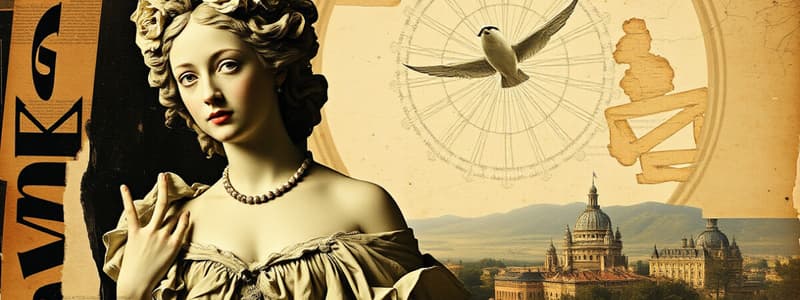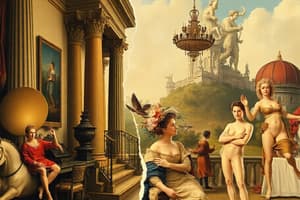Podcast
Questions and Answers
Compare and contrast Rococo and Neoclassical art in terms of subject matter and style.
Compare and contrast Rococo and Neoclassical art in terms of subject matter and style.
Rococo is a light-hearted, whimsical style focused on people and nature, while Neoclassicism emphasizes courage, sacrifice, and nationalism, with a focus on classical traditions.
How does Neoclassicism differ from the Renaissance era's revival of the classical past?
How does Neoclassicism differ from the Renaissance era's revival of the classical past?
Neoclassicism was influenced by the politics of Europe and aimed to inspire patriotism, while the Renaissance focused more on human emotion and realism.
What role did art play in the Revolution of 1789 and its aftermath in France?
What role did art play in the Revolution of 1789 and its aftermath in France?
Art served as a tool for educating the public and promoting feelings of nationalism and civic virtue during the Revolution.
Which examples from the past did early leaders of the United States choose to emulate in their buildings?
Which examples from the past did early leaders of the United States choose to emulate in their buildings?
Compare Ingres's work to that of Delacroix.
Compare Ingres's work to that of Delacroix.
How do the artistic aims of early photography coincide with those of painting from the same time?
How do the artistic aims of early photography coincide with those of painting from the same time?
Identify the formal artistic differences between Neoclassicism and Romanticism.
Identify the formal artistic differences between Neoclassicism and Romanticism.
Why did Neoclassicism appeal to political leaders like Napoleon in the 19th century?
Why did Neoclassicism appeal to political leaders like Napoleon in the 19th century?
Discuss the emergence of Realism and the characteristics of the style in the middle of the 19th century.
Discuss the emergence of Realism and the characteristics of the style in the middle of the 19th century.
What is meant by the term 'academic art'?
What is meant by the term 'academic art'?
In what ways did the Post-Impressionist art of the later 19th century break from the past?
In what ways did the Post-Impressionist art of the later 19th century break from the past?
How did artists from the late 19th century call attention to the 'facts' of art making?
How did artists from the late 19th century call attention to the 'facts' of art making?
Why did the public find the subjects, forms, and techniques of the Impressionists shocking?
Why did the public find the subjects, forms, and techniques of the Impressionists shocking?
Discuss the sculptural innovations of the late nineteenth century sculptor Rodin.
Discuss the sculptural innovations of the late nineteenth century sculptor Rodin.
Flashcards are hidden until you start studying
Study Notes
Rococo vs. Neoclassical Art
- Rococo is characterized by whimsical, light-hearted themes, with a focus on decorative arts and grand architecture.
- Neoclassicism emphasizes themes of courage, sacrifice, nationalism, and a revival of ancient Greece and Rome, focusing on idealized forms and structured compositions.
- Rococo works often showcase aristocratic scenes; for example, Watteau's "Pilgrimage to Cythera" highlights romantic themes with vibrant colors.
- Contrastingly, Neoclassical works like David's "Oath of Horatti" focus on Enlightenment values such as loyalty and patriotism.
Differences Between Neoclassicism and Renaissance
- Neoclassicism arose as a response to political changes, particularly the French Revolution, unlike the Renaissance, which centered on human emotion and realism.
- Neoclassical art is influenced by Enlightenment ideals, while Renaissance art sought to revive classical thought with a focus on human experience and emotion.
- Artists in the Neoclassical period aimed to inspire patriotism, distinguishing it from the emotional and realistic portrayals of the Renaissance.
Art's Role in the 1789 Revolution
- Jacques-Louis David viewed art as a means of guiding and educating the public, using dramatic, nationalistic themes as rallying calls.
- Neoclassical art replaced Rococo's frivolity, focusing on patriotic messages that supported the revolution and civic virtue.
- David's "Death of Marat" serves as a poignant memorial and propaganda piece for revolutionary ideals.
Neoclassical Influences on U.S. Architecture
- Thomas Jefferson modeled key buildings on classical structures, such as the State Capitol after Maison Carrée and the University of Virginia after the Pantheon.
- The design aimed to reflect Enlightenment principles, advocating civic duty and patriotism through Greco-Roman architectural styles.
- Jefferson's architectural choices were meant to inspire adherence to democratic values and enlightenment thoughts.
Ingres vs. Delacroix
- The artistic rivalry between Ingres and Delacroix represents a broader debate over academic tradition versus romantic expression.
- Ingres favored classical form and precision, contrasting with Delacroix's focus on dramatic emotion and color.
- This rivalry reflects earlier debates between different artistic philosophies and their respective impacts on European art.
Early Photography and Its Impact on Painting
- Early photography shared aims with painting by capturing reality and exploring new forms of expression.
- The rise of photography prompted painters to innovate and redefine their roles, often leading to more abstract or subjective depictions.
- Notable 19th-century photographers, such as Julia Margaret Cameron, sought to elevate photography to fine art, paralleling painting's evolution.
Neoclassicism vs. Romanticism
- Neoclassicism is defined by order, clarity, and adherence to classical ideals, while Romanticism emphasizes emotion, individualism, and the sublime.
- Examples of Neoclassicism include David’s works, highlighting narratives of heroism; Romanticism is represented by Turner’s expressive landscapes that evoke strong emotional responses.
Neoclassicism and Napoleon's Propaganda
- Neoclassicism appealed to Napoleon due to its themes of power, authority, and idealized historical narratives.
- Napoleon utilized art as propaganda, commissioning works that glorified his reign and aligned him with classical grandeur, such as in the visual portrayal of his coronation.
Emergence of Realism
- Realism emerged in the mid-19th century, characterized by a focus on everyday subjects and social conditions.
- Realist paintings challenged romanticized depictions, often highlighting the struggles of common people; Courbet’s works exemplify this, depicting laborers and social inequality.
Academic Art and Impressionism
- "Academic art" refers to styles that adhere to traditional academic standards and conventions, emphasizing meticulous technique and historical themes.
- Impressionists broke from this by experimenting with light and color, often capturing fleeting moments; works such as Monet's "Impression, Sunrise" embody these characteristics.
Post-Impressionist Innovations
- Later 19th-century Post-Impressionists broke from previous styles by exploring abstraction and emotional expression.
- Artists like Van Gogh and Cézanne approached color and form uniquely; Van Gogh's expressive brushwork diverged significantly from earlier realism.
Late 19th Century and 'Facts' of Art Making
- Artists focused on the medium and process of art, emphasizing the 'facts' of creation rather than solely representational accuracy.
- Movements encouraged experimentation, leading to various styles that questioned traditional artistic norms and definitions.
Public Reaction to Impressionism
- The term "Impressionist" was initially derogatory, as the public found the loose brushwork and unconventional subjects shocking.
- Impressionist techniques, like capturing light and movement, deviated significantly from the detailed realism that the audience was accustomed to.
Rodin's Sculptural Innovations
- Rodin challenged traditional sculptural forms through dynamic poses and textured surfaces, focusing on emotional and psychological depth.
- His works, such as "The Thinker," exemplify a break from static forms to more expressive, free forms that convey movement and thought.
Studying That Suits You
Use AI to generate personalized quizzes and flashcards to suit your learning preferences.




